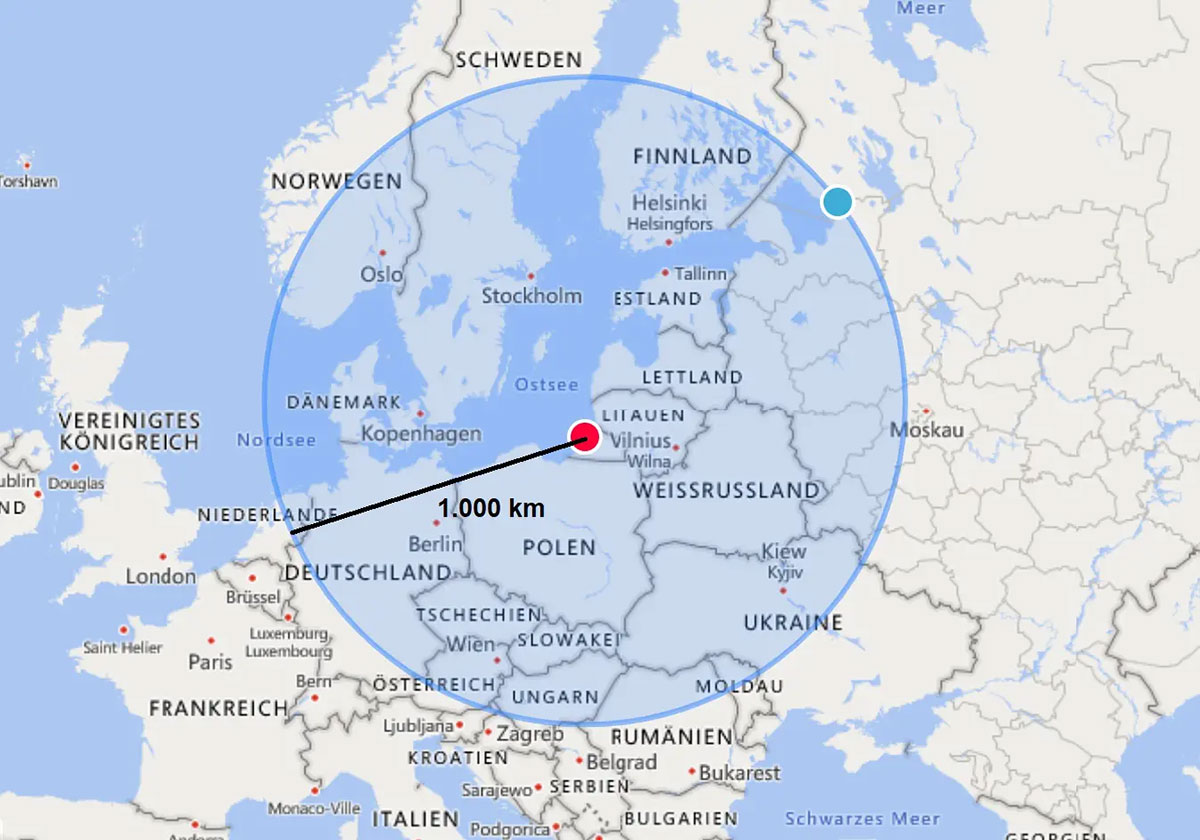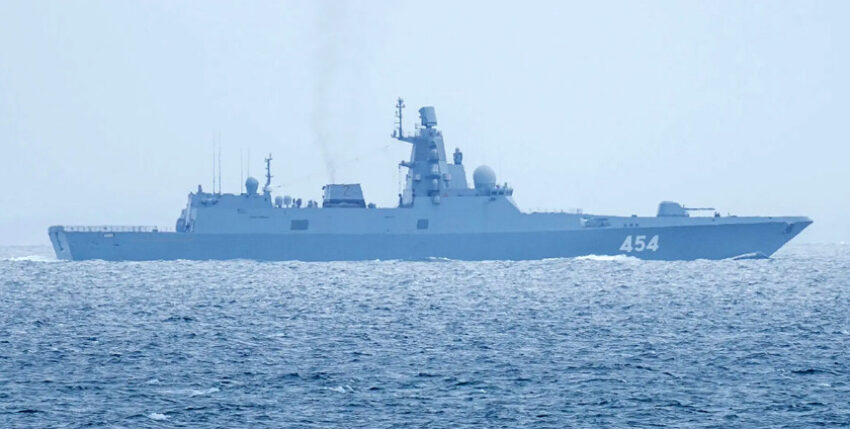On the morning of 7 July 2022, the Russian frigate "Admiral Gorshkov" (Hull number 454) passed through the Fehmarnbelt. The ship, which belongs to the Northern Fleet of the Russian Federation, is expected to take part in the Russian Navy's naval parade in Kronstadt/St. Petersburg. Remarkably, the 3D surveillance radar FURKE rotated. This seems unusual, as in the past Russian units only used their navigation radar systems for such passages. The "Admiral Gorshkov" bears the symbol of the Russian war against Ukraine, the letter Z on its funnel.
Construction programme project 22350
The 135 metre long, 5,400 tonne displacement unit is a new Russian class of multi-purpose frigate that is considered the successor to the Krivak class. Two units are currently in service, with six others in various stages of construction, of which "Admiral Golovko" is the most advanced. Two additional frigates were ordered in August 2020. According to experts, the Russian Navy needs thirty units to replace its remaining predecessors. Construction of the "Admiral Gorshkov" began in 2006 and it was commissioned in 2018. Construction number 2, "Admiral Kasatonov", was launched in 2009 and commissioned into the navy in 2020. According to an announcement by the Severnaya shipyard in August 2021, sea trials of construction number 3, "Admiral Golovko", which began in 2012, can begin in mid-2022. Russian sources expect it to be handed over to the navy in 2022 and assume that the seven other frigates will be completed by 2027.
Armament project 22350
The Admiral Gorshkov class (Russian: Project 22350) deploys its main armament from a 16-cell vertical launch system (VLS Vertical Launch System). They can be used to launch Kalibr cruise missiles (range 2,500 km), Oniks ship-to-ship missiles (range 300-500 km), the hypersonic Zircon and anti-submarine missiles. A further 32-cell vertical launch system (VLS) is reserved for medium-range air defence missiles. The armament is completed with a 130-mm turret, two 30-mm short-range defence cannons and torpedo launchers. It is possible to accommodate (including hangar) a KA-27 helicopter (NATO designation Helix).
Challenge: Zircon missiles
"Admiral Gorshkov" conducted a test firing of a Zirkon hypersonic missile in the Barents Sea on 28 May. It is considered to be the first successful test of this weapon system over its full range. Zirkon (Russian designation: 3M22 Tsirkon (Циркон), NATO designation: SS-N-33) is designed to reach nine times the speed of sound (Mach 9). The payload is 300 kilograms. The warhead can be conventionally or nuclear-tipped. The weapon system is designed for both sea and land targets and can be deployed by surface units and submarines. A land-based version is currently under development.
As the fastest non-ballistic missile in the world and with its ability to manoeuvre in flight, Zircon poses a challenge to Western missile defences. In this respect, against the background of the current situation, the presence of the "Admiral Gorshkov" in our front yard means more than just sending a naval unit to celebrate the fleet's birthday. The situation, which already deserves attention due to the Iskander missile systems stationed in the Russian enclave of Kaliningrad, has become even more acute.
Last year, Russian head of state Vladimir Putin had a trio of nuclear submarines launched in the Baltic Sea - a first at the time. These included the Russian navy's most modern nuclear weapon carrier, the submarine "Prince Vladimir" with 16 possible intercontinental missiles and 96 nuclear warheads.

31 July 2022 - Day of the Russian Navy
Navy Day is a bank holiday in the Russian Federation that is traditionally celebrated on the last Sunday in July and on which the sailors of the Russian Navy and its special units are honoured. In 2022 it will be celebrated on 31 July. After Victory Day (9 May), Russian Navy Day (День Военно-Морского Флота) is the second largest military holiday in Russia. Since 2017, the central celebrations have been held in St Petersburg as a naval parade of ships and flying units from the Baltic, Black Sea, Northern and Pacific Fleets and the Caspian Flotilla. Events are also held at other naval bases. Navy Day was originally introduced in 1696, but was abolished by the Soviet Union in 1980. President Putin revived it.
Citing Defence Minister Sergei Shoigu, TASS reported at the beginning of June that 47 floating units will take part this year.
+++++++++++++++











5 responses
The Day of the Russian Naval Fleet was not abolished by the Soviet Union in 1980; rather, it was moved from a fixed day (24 July) to the last Sunday in July and celebrated annually.
In 2017, President Putin introduced the tradition of the "Main Naval Parade" in St Petersburg and Kronstadt, in which all fleets and the Caspian Flotilla participate locally.
This year, the nuclear submarine "Severodvinsk" ("Северодвинск" [project 885]) and the
the large landing ship "Ivan Gren" ("Иван Грен", project 11711), as well as the (civilian) sail training ship "Sedov" ("Ceдов") will take part in the main naval parade, as reported by the weekly newspaper of the Baltic Fleet "Strazh Baltiki" in the issue of 24 June 2022.
Thank you very much, Mr Engel.
I have already replied to you by email.
Unfortunately, I will not be able to receive Severodvinsk and Ivan Gren in person ...
Although I'm unsure about IG whether she's actually taking part. Because IMO she is in the Black Sea.
Best regards
hum
Dear Mr Mergener,
The sister ship, the "Petr Morgunov" ("Пётр Моргунов"), is located in the Black Sea.
The "Ivan Gren" ("Иван Грен") has just completed a three-month lay-up at the "Yantar" shipyard in Kaliningrad and is preparing to be transferred to Saint Petersburg. (read here: https://tass.ru/armiya-i-opk/15221557)
The day was introduced in honour of the victory at the Battle of Gangut in 1714 by Peter the Great, and thereafter celebrated annually as Victory Day in this battle with church services, fireworks and naval parades. Over time, there have been several changes to the date of the day. In 1980, it was not abolished, but fixed to the last Sunday in July. This has not changed to this day. Incidentally, Defender of the Fatherland Day on 23 February, Airborne Forces Day on 2 August and the days of honour of other branches of the armed forces are celebrated with just as much enthusiasm.
The Zircon has not yet been adopted into the armament. Incidentally, carriers of the Kalibr missiles in various modifications have already been in the Baltic fleet for several years. And as far as I know, the IG is on its way.
Given the number of VLS compartments, the German F125 and the planned F126 appear to be ridiculously under-armed.